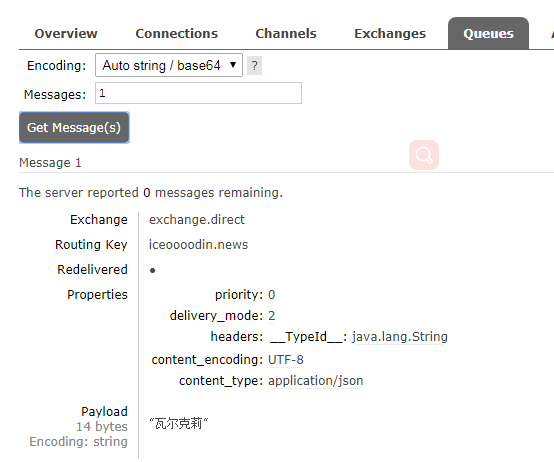SpringBoot日记——MQ消息队列整合(二)
基于第一篇文章搭建好环境以后,我们这篇文章继续介绍如何在springboot中使用RabbitMQ。
1)、单播:添加好pom文件和自定义配置后,来看:
@Autowired RabbitTemplate rabbitTemplate; @Test public void contextLoads() { // 对象被默认JAVA序列化发送,参数:Exchange,routingKey,消息 rabbitTemplate.convertAndSend("exchange.direct", "iceoooodin.news", "瓦尔克莉"); }
来看看我们发送的消息是否成功了:

如图,成功获取了~。
同样,使用代码来直接获取:
@Test public void receive() { // 接受数据 Object o = rabbitTemplate.receiveAndConvert("iceoooodin.news"); System.out.println(o.getClass()); System.out.println(o); }
另外,我们除了str类型,还是发送map、对象等等,比如:
@Test public void contextLoads() { Map<String, Object> map = new HashMap<>(); map.put("msg", "第一个数据"); map.put("data", Arrays.asList("helloworld", 123, true)); // 对象被默认JAVA序列化发送 rabbitTemplate.convertAndSend("exchange.direct", "iceoooodin.news", map); }
@Test public void contextLoads() { // 对象被默认JAVA序列化发送 rabbitTemplate.convertAndSend("exchange.direct", "iceoooodin.news", new Book("金瓶M", "em..")); }

public class Book { private String bookName; private String author; @Override public String toString() { return "Book{" + "bookName='" + bookName + '\'' + ", author='" + author + '\'' + '}'; } public Book(String bookName, String author) { this.bookName = bookName; this.author = author; } public Book() { } public String getBookName() { return bookName; } public void setBookName(String bookName) { this.bookName = bookName; } public String getAuthor() { return author; } public void setAuthor(String author) { this.author = author; } }
2)、然后我们来看广播,也就是发送一堆消息是如何处理的:
@Test public void sendMst() { rabbitTemplate.convertAndSend("exchange.fanout", "", new Book("红楼", "草 ")); }
如果发送的是广播,可以发现,消息会被分别发送到匹配的全部消息队列中:

3)、我们学会发送和接收了,再看看如何创建Exchange或者Queue吧,我们创建和绑定写在了一起,根据需要自己拆:
@Autowired AmqpAdmin amqpAdmin; //这个amqpadmin是用来管理QP的,可以创建、删除等操作; @Test public void creatExchange() { // 创建Exchange amqpAdmin.declareExchange(new DirectExchange("amqpadmin.exchange")); System.out.println("创建exchange完成"); // 创建Queue amqpAdmin.declareQueue(new Queue("amqpadmin.queue", true));
System.out.println("创建Queue完成"); // 绑定 amqpAdmin.declareBinding(new Binding("amqpadmin.queue", Binding.DestinationType.QUEUE, "amqpadmin.exchange", "amqp.haha", null)); }
结果就懒得写了,大家自己试验看一下就知道了,到web管理界面看看是否有正确添加和绑定~





 浙公网安备 33010602011771号
浙公网安备 33010602011771号